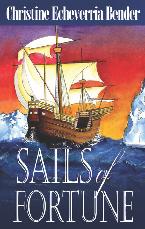 Having read Laurence Bergreen’s description of Magellan’s circumnavigation of the globe, Over the Edge of the World (see this post), I was very interested in Christine Echeverria Bender’s take of the same voyage, Sails of Fortune, partially because I found Bergreen’s account so fascinating, but also because I knew Bender’s would cast a more favorable light on her central protagonist, the Basque mariner Juan Sebastian de Elcano.
Having read Laurence Bergreen’s description of Magellan’s circumnavigation of the globe, Over the Edge of the World (see this post), I was very interested in Christine Echeverria Bender’s take of the same voyage, Sails of Fortune, partially because I found Bergreen’s account so fascinating, but also because I knew Bender’s would cast a more favorable light on her central protagonist, the Basque mariner Juan Sebastian de Elcano.
When I first began Sails of Fortune, I was a bit apprehensive as I typically like my history with just the facts, as we know them, and not wrapped in fictional embellishments. Thus, I enjoyed Bergreen’s book as that was his approach, though he did let himself editorialize at times. And I was hesitant to begin Bender’s book, as she takes the opposite approach and couches the voyage from Elcano’s point of view, which requires liberties to be taken, especially as comes to motivation and impression of events.
Bender describes the voyage from the perspective of Elcano. Thus, some major events, such as the eventual death of Magellan, receive very little “screen” time as Elcano wasn’t present (he was on board his ship sick during the battle that lead to Magellan’s death). She does share her interpretation of Elcano’s reaction to the news and a brief retelling of the battle as one of those present reports the events to Elcano.
Despite my initial misgivings, I really enjoyed this novel and especially the telling of events from Elcano’s point of view. And I understand now why this approach, of trying to recreate the events from the perspective of one of the participants, is valuable, as having Elcano’s reaction to events described, even if to some degree they must have been fabricated, put those events in perspective and gave them more impact. I think I retained more about the facts of the voyage because of this than I did for Bergreen’s book (leading me to have to make some corrections when I posted my original thoughts here). Of course, this does lead me to wonder how much of Elcano’s thoughts Bender might have gleaned from his diary and how much is pure invention. Even so, even if the Elcano of Bender’s novel is not so similar to the real Elcano, he is definitely a character full of life and brings the voyage to life.
The facts of the voyage are consistent with Bergreen’s description. The main deviations occur in describing reactions to events. Bender makes Elcano out to be a very different character than Bergreen: Bender’s Elcano is a somewhat unwilling participant in the mutiny at San Julian while he is a central plotter in Bergreen’s book. Bergreen’s Elcano resents the status of men he considers his lessers, at least in terms of navigation experience, and he becomes bitter, while Bender’s Elcano is much more stoic and gracious and even turns down an offer to lead the expedition after Magellan is killed. Which is more accurate is hard to say, but both presumably draw on Elcano’s own diaries so it isn’t clear to me how much is each author’s interpretation of Elcano’s entries and how much is the result of their own biases.
One thing I found very interesting about Bender’s account is how personal the struggles and suffering of the men of the expidition became. Whether when in chains as a result of their failed mutiny (and the frustrations they had that led to that mutiny) or the true horror they must have faced when crossing the Pacific and falling to the ravages of scurvy, Bender gives us an inkling of how these men must have felt. From the beginning, we know that Elcano eventually returns to Spain, but by giving life to some of the other sailors serving with Elcano, by creating relationships between them and Elcano, the true suspense comes from who else will survive. After all, of the 237 men who left Spain, only about 30 returned.
Bender wastes no time on things that Elcano does not know. For example, Bergreen spends significant time on the desertion of the ship San Antonio and the capture of the ship Trinidad by the Portuguese. However, both of these events were things that were unknowable to Elcano, so we don’t really learn much about them. After he returns to Spain, Elcano learns that indeed the San Antonio had deserted the expedition, but little more is said.
Overall, once I got past my reluctance to begin this “historical fictional” novel, I was really sucked in and enjoyed it immensely. I now understand the value of these types of accounts of historical facts. I’m not sure I am ready to delve into many more of these, still preferring the more straight-forward factual accounts, but I’m definitely interested in reading Bender’s next book, The Whaler’s Forge.
Visit Christine Bender’s website for news on her upcoming book, The Whaler’s Forge.
For more information about Magellan and the voyage, see this Wikipedia article. This Wikipedia article focuses on Elcano.
Discover more from Buber's Basque Page
Subscribe to get the latest posts sent to your email.

